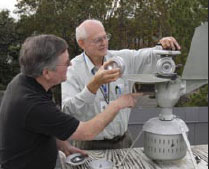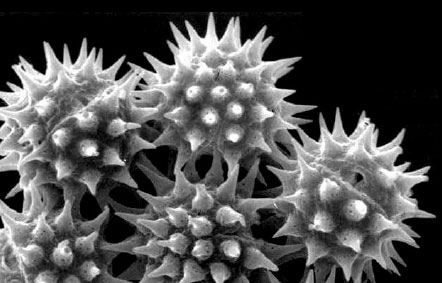
Photo by D.M. Jarzen
Gesundheit! Bless You! Approximately 41 million Americans suffer from allergies caused by pollen and mold spores. These allergies, grouped under the common medical term allergenic rhinitis, are persistent, often chronic, and cost sufferers millions of dollars annually in prescription and non-prescription drug treatments. Florida ranks high on the list of United States areas where abundant, airborne pollen and mold spores produce mild to strong allergic reactions.
Recording the plants that produce allergy causing pollen or mold spores, making daily counts of these types and mapping their changes in abundance is important in allergy control. Florida’s long flowering season and short winters are responsible for large amounts of pollen year-round. From March to April, Florida boasts 167 plants that begin to produce pollen, of which at least 60 species are known to produce allergic reactions in humans. Through a continuous record collected over several years, scientists and doctors can predict and inform patients which pollen type is most abundant and more precisely diagnose their allergy. Simply avoiding outdoor activity when specific allergenic pollen is abundant provides much needed relief to many hayfever sufferers.
Forecasting requires careful pollen and mold spore identification and counting. Fortunately, each pollen type and mold spore has a unique shape, ornamentation, number of pores and other features that allow identification to a particular plant species. Florida Museum of Natural History scientists began collecting daily pollen counts from the Dickinson Hall roof five years ago with the help of Dr. Mary L. Jelks and Dr. Mark Ticola of Sarasota, Fla., and Amada Bishop of New York.
The counts are taken using a Burkard® seven-day pollen collector, consisting of a metal box attached to a vacuum pump and a small opening through which air is pulled. Directly behind this opening is a large disk with adhesive tape that moves 2 millimeters an hour. The tape traps the pollen and mold spores continuously for 24 hours a day, for up to one week.

Photo by Jeff Gage
In the laboratory, scientists remove the tape and analyze it under a microscope, generally magnified 400 times to count the pollen grains. For some mold spores, the sample must be magnified 1,000 times. Using exposure time, volume of air sampled and number of pollen grains or mold spores counted, calculations can be made to determine the number of pollen grains and mold spores per cubic meter of air sampled. This is the number the Museum reports to the local newspaper and to a local allergist, Dr. A. Karadsheh.
Pollen counts often report the pollen numbers for a particular plant group, such as grasses, trees, mold and weeds as high, moderate, low or absent. In other reports, counts are given as actual numbers of grains per cubic meter of air. A cubic meter of air is equal to 1.3 cubic yards, or about the size of a small desk. Many people begin to suffer from allergy symptoms when counts reach only 20 to 100 grains per cubic meter.

Photo courtesy of Gretchen D. Jones
A high pollen count does not necessarily mean a person will suffer on that particular day. If a person is allergic to high concentrations of ragweed pollen, but the pollen count that day indicates that the numbers are high due to an abundance of oak tree pollen, and very little ragweed pollen, that person may not be affected at all. In the northern United States, pollen counts are low or absent during the winter months. However in Florida, it is necessary to make daily pollen counts year-round, because some plants may flower during winter, and molds continue to produce abundant spores, capable of causing allergies in many residents.
The pollen counts collected and reported at the Florida Museum are generally valid for much of north-central Florida, as most of the pollen captured by the Burkard pollen collector is from plants that produce airborne pollen and spores that may travel great distances. Occasionally following a heavy windstorm, pollen of plants that produce animal-pollinated pollen may be observed in the counts. Dust from Mongolia was detected once following extreme dust storms in that region.
Florida Museum pollen counts are vital for the health of north-central Florida residents and require about $6,000 per year to continue. For more information, or to make a tax-deductible donation in support of this work, call (352) 846-2000, ext. 256.
David Jarzen and David Dilcher are research scientists with the Florida Museum of Natural History specializing in the study of plant fossils and their ancient environments. Hu Shusheng is a Ph.D. graduate student at the University of Florida in the Department of Geology, working under the supervision of Dilcher and Jarzen.
Learn more about the Paleobotany & Palynology Collection at the Florida Museum.

